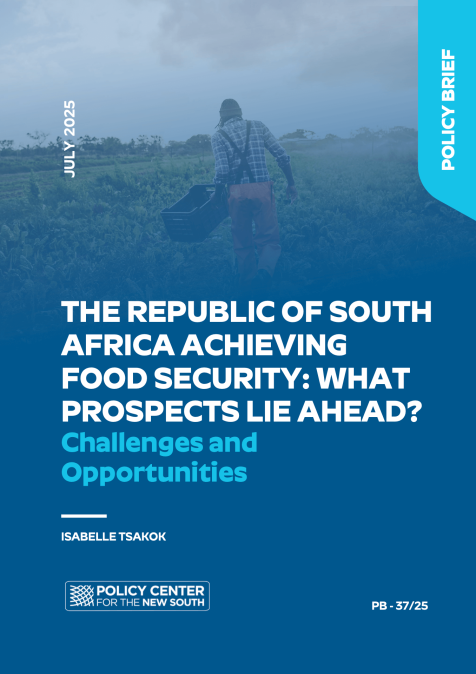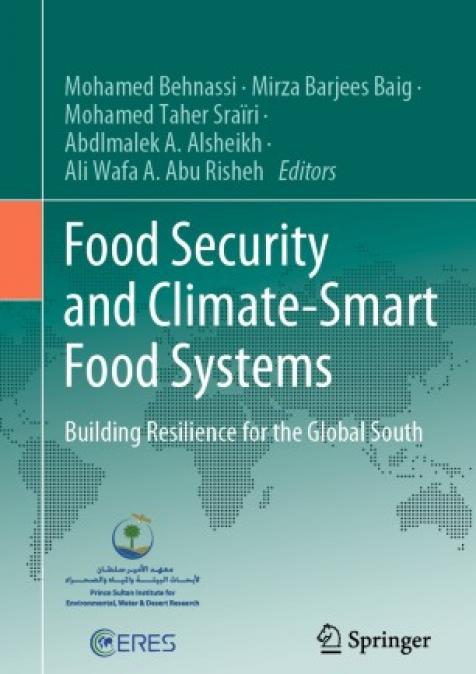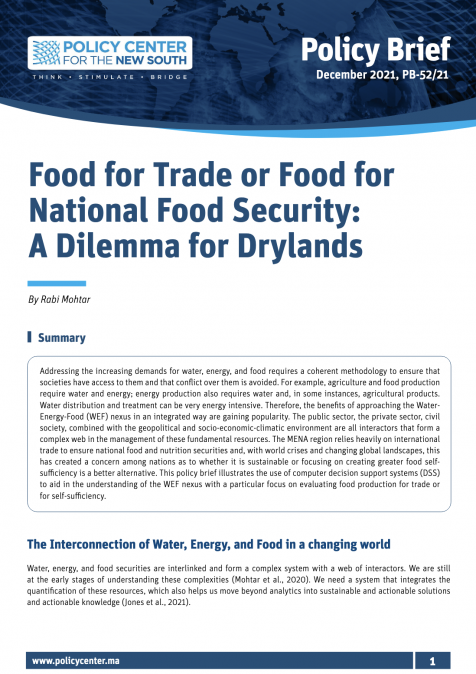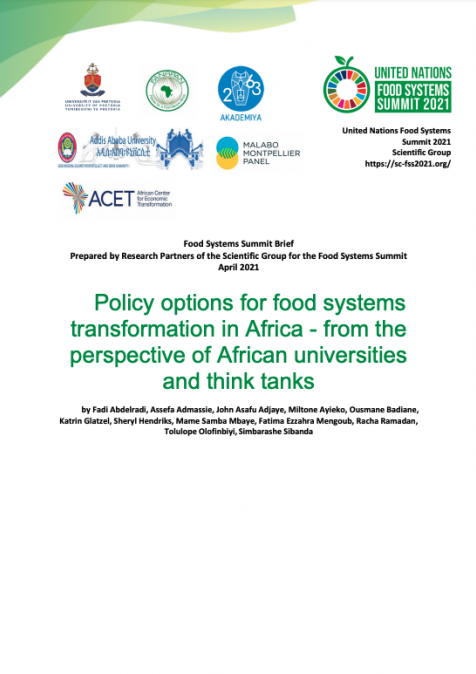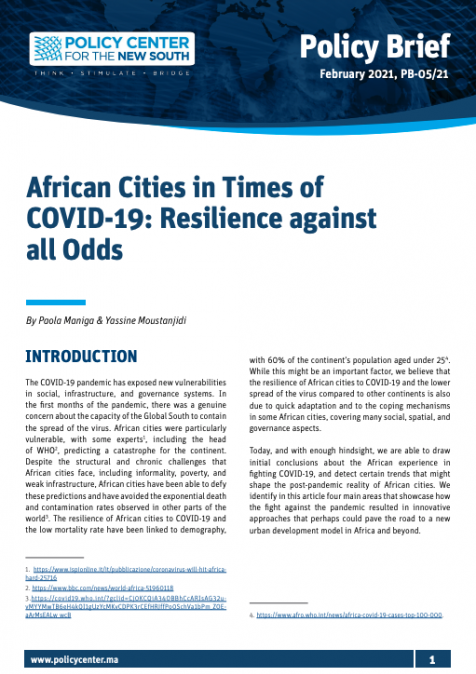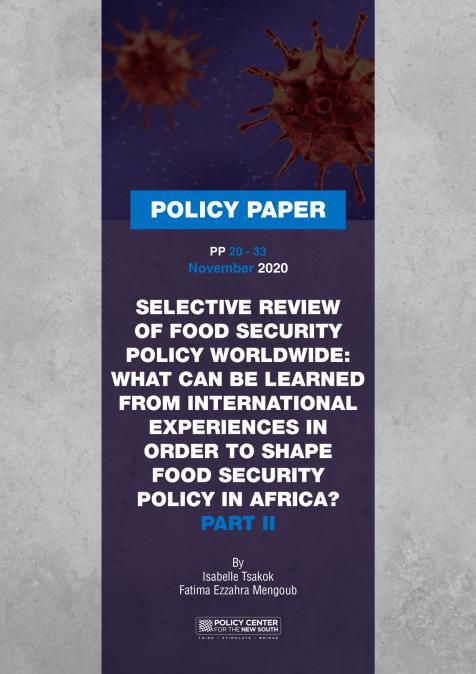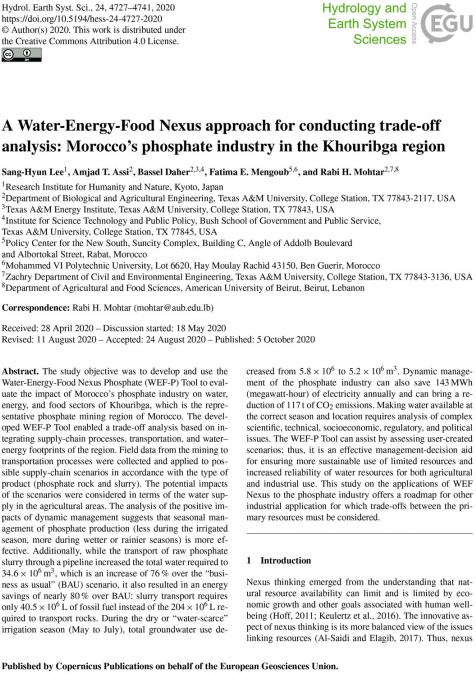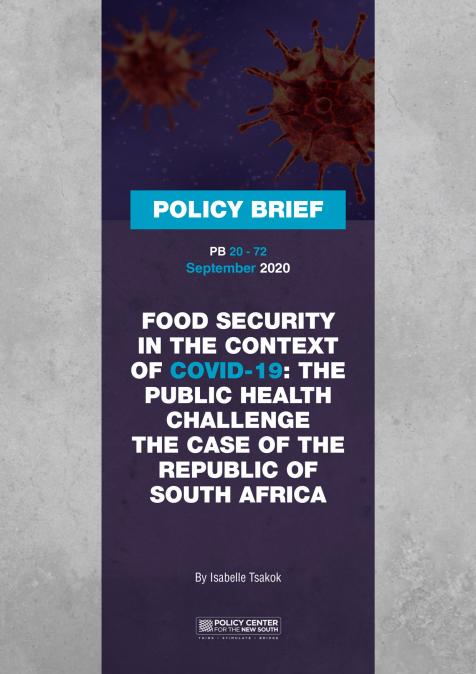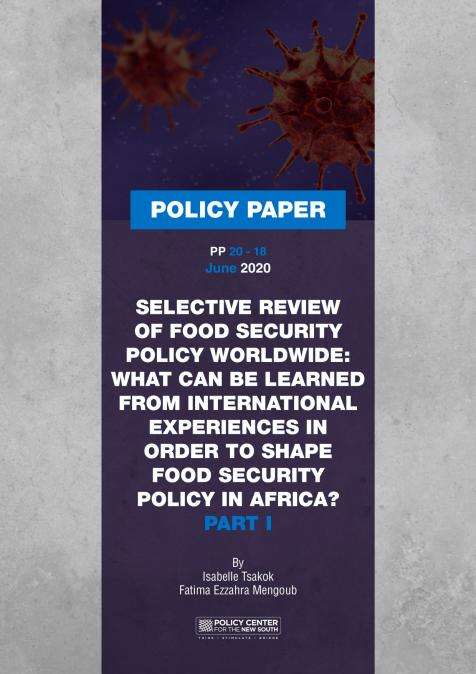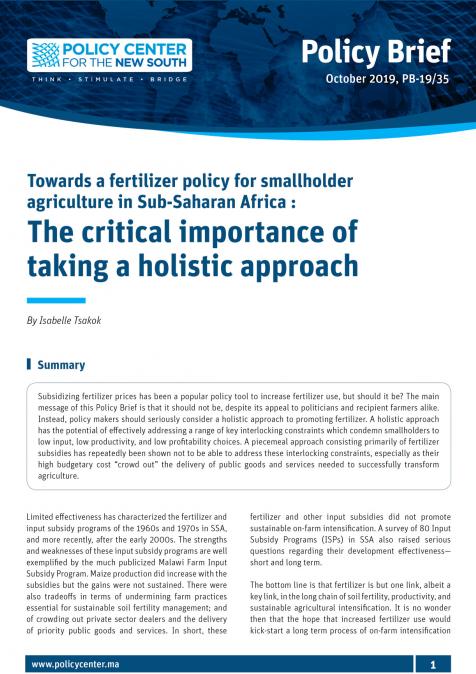Publications /
Policy Brief
A generation after the end of Apartheid in 1994, the Republic of South Africa is once again at a critical juncture in its long march to realize Mandela’s vision of a society that enjoys six freedoms: freedom from want, hunger, deprivation, ignorance, suppression and fear.
While much has been achieved in advancing these freedoms, much remains to be done. South Africa today continues to grapple with substantial poverty and hunger, high unemployment especially among youth and deep inequities inherited from Apartheid. The government has yet to fulfill the promise of transformative land restitution and land reform.
Facing the existential threat of climate change and a significant youth bulge, South Africa’s ongoing struggle can realize Mandela’s vision by seizing the golden opportunity offered by the AfCFTA’s continent-wide markets, while building on its considerable domestic assets such as strong public institutions and high-performing modern subsectors.
South Africa’s success or lack thereof in building an inclusive, resilient, and high-growth economy serves as a test case for the strengths and limitations of relying on a market-oriented approach to redress deep socio-economic inequities.
Introduction: Scope and Organization
In 1994,[1] the peaceful transition from Apartheid South Africa (1948-94) to a multi-racial democratic republic was rightly hailed as a tour de force, unique on the world stage. A full generation later, however, 21st century South Africa continues to struggle with the deep inequities of a dualistic economy created by Apartheid a textbook case of an extractive economy. Mandela’s approach to regaining political power for Blacks, the majority, provided an excellent foundation for the transition to multi-racial democracy but was far from sufficient to overcome these entrenched inequities.[2]
Overcoming these deeply rooted inequities remains the overarching challenge for post-Apartheid governments. In its National Development Plan (2012), the key goals of South Africa’s Vision 2030 are to eliminate poverty and promote shared prosperity. Achieving both will inevitably require a significant reduction in these inequities. What are the prospects for South Africa to achieve these goals?
To address this question, Section I presents a brief overview of selected South African experiences during and since the end of Apartheid, emphasizing the country’s main structural strengths and weaknesses. Section II focuses on the extent and incidence of poverty within the broader context of high income and wealth inequality. Section III discusses the agriculture and agri-food sectors under the threat of climate change, highlighting their dualistic nature. Sector IV examines how South Africa plans to tackle its two key challenges the major trends of climate change and the youth bulge and explores possible options likely to shape the country’s prospects for a food secure future.
Will South Africa continue to struggle in reducing inequities related to access to land, as well as to other critical assets such as financial and human capital and economic opportunities?
At the outset, we would like to clarify that this project brief adopts the FAO (1996) concept of food security, which states that:
“Food security exists when all people at all times have physical and economic access to sufficient, safe, and nutritious food to meet their dietary needs and preferences for an active and healthy life.”
This holistic concept often referred to as food and nutrition security (FNS) is realized when the four pillars of availability, access, utilization and stability are simultaneously met. The FAO concept is frequently contrasted with other two widely used frameworks: food self-sufficiency (FSS) and food sovereignty (FSY). FSS refers to a country’s ability to meet its population’s consumption needs typically for basic staples entirely through domestic production. FSY, first articulated by La Via Campesina (1996) and further elaborated in the Declaration of Nyeléni (2007), holds that:
“Food sovereignty is the right of peoples to healthy and culturally appropriate food produced through ecologically sound and sustainable methods, and their right to define their own food and agriculture systems.”
The food self-sufficiency concept values the ability of local food producers to satisfy all domestic consumption. The food sovereignty concept prioritizes the ability of local food producers to determine their food systems without depending on global markets or multinational corporations.
In contrast to FSS and FSY which often appeal to nationalism and advocate for trade protection the FAO concept of food security (FNS/FSH) is policy-neutral and does not prescribe any particular trade or market orientation. For all three concepts, it is matter of degree the extent to which each is realized.
Section I: Overview of Key Features of South Africa’s Experiences During and Since the End of Apartheid
Selected Features of South Africa’s Socio-Economic and Trade Experiences under Apartheid:
Under British and later Afrikaner rule, South Africa developed deeply dualistic and protectionist systems that institutionalized racial separation and inequality. The Apartheid regime maintained strict segregation, ensuring White domination through a series of measures:
- White Dominance in Land Ownership: Although the White population declined from roughly 20% in the 1940s to around 10-13% in the 1990s, it continued to control the vast majority of South Africa’s assets. By 1994, approximately 87% of the land was owned by this White minority (Atuahene, 2011).
- The Natives Land Act (1913) This law enforced spatial segregation by restricting Black South Africans through the creation of Homelands on the remaining 13% of the land. It also laid the foundation for the creation of ten Homelands, designated for specific ethnic groups.[3]
- The Menial Role of the Homelands: These areas were marked by poor agricultural soils and severe overcrowding. Designated as reservoirs of cheap labor, the Homelands compelled Black South Africans to migrate for work mainly on White-owned farms, in mines,[4] and in urban centers run by White South Africans.
- Comprehensive State Assistance to Agri-Food Systems Operated by Whites: In addition to White dominance in land ownership, the Apartheid governments ensured that White farmers and agro-processors thrived by providing comprehensive policy support such as subsidized credit, guaranteed output prices through marketing control boards, and high trade protection of an import-substitution strategy. Meanwhile, Black farm laborers were confined to degraded land and lacked any real bargaining power. Their meager remuneration was typically paid in kind rather than in cash, forcing many into debt at local farm stores (Helliker, 2013).
- Skilled and Semi-Skilled Labor Market for Whites Only: Another important tool of domination was the denial of access to quality education for Blacks and other non-Whites. This systemic inequity ensured they were excluded from semi-skilled and skilled jobs. The Bantu Education Act (1953) cemented educational segregation. The curriculum for Black learners referred to as “native education” deemphasized basic skills in arithmetic and language, as they were to be prepared only for unskilled labor. Schooling was compulsory for Whites from age 7 to 16; for Blacks, from 7 to 13; and for Asians and Coloreds, from 7 to 15. Education funding disparities were also stark: average teacher-to-pupil ratios were 1:18 for Whites, 1:39 for Blacks, 1:24 for Asians, and 1: 27 for Coloreds. Moreover, while 96% of teachers in White schools held teaching certificates, only 15% of teachers in Black schools were certified (Ocampo, 2004).
- Mobility Control of Blacks, as Cities Were Reserved for Whites: The Natives Urban Act (1923) allowed Black South Africans to enter cities only as temporary labor for White households. They were confined to townships on the urban periphery.
The Apartheid government operated as a police state, enabling a White minority to exercise near total control over the livelihoods of the Black majority for nearly half a century. Thirty years after the end of political Apartheid, the African National Congress (ANC) Government is still struggling to uproot the deep structural inequities inherited from that system.
Selected Features of South Africa’s Socio-Economic and Trade Experiences Post-Apartheid: Once in power in 1994, the ANC government began addressing key inequities. While there has been meaningful progress, there have also been serious setbacks. At least four major areas stand out:
- Arable land remains highly unequal despite GOSA’s efforts: One of the most politically sensitive areas for improving equity and opportunity is in the distribution of arable land. The Government of South Africa’s (GOSA) Land Restitution Act (1994) enabled land reform through three mechanisms: (i) restitution of land rights,[5] (ii) land redistribution,[6] and (iii) tenure reform.[7] GOSA initially aimed to redistribute 30% of arable land to Black South Africans by 2014. However, this goal remains far from achieved. Post-2014 data on actual land transfers is limited, but land distribution remains highly skewed (World Bank Group, 2018 and 2021). The process has proven to be legally and administratively complex and financially burdensome. For instance, during President Zuma’s tenure, the government reportedly ran out of funds to continue the restitution program. The government’s inability to deliver on land restitution and reform is seen by some as “a sea of oil waiting for a match” (Atuahene, 2011).[8] To the extent that this sentiment is widely shared,[9] stalled progress on this politically charged issue is deeply concerning. As of 2024, it is estimated that White commercial farmers still own 61 million hectares 78% of farmland with private title deeds, or approximately 50% of all land in South Africa (Gumbi et al., May 2024).[10]
- Smallholder Black agriculture suffers from inadequate state support: In contrast to the comprehensive state assistance that enabled White agriculture to thrive under apartheid, GOSA has been criticized for failing to provide Black smallholders with the necessary support to succeed. This includes financial assistance, technical guidance, infrastructure, and services related to agricultural research, extension, and training. For example, many smallholders lacked even basic irrigation tools and access to electricity. Whether this constitutes a “recipe for disaster” or not (Atuahene, 2011), it certainly undermined the development of high-productivity and profitable Black smallholder agriculture during its crucial early stages. To this day, Black smallholder agriculture remains hampered by tenure insecurity, ineffective land administration services, and inadequate policy and investment support.
- Despite improvements, poor quality education remains a major contributor to the shortage of semi-skilled and skilled Black workers and persistently high Black unemployment: Under Apartheid, the ANC[11] strongly opposed the Bantu Education Act of 1953. Once in power, GOSA abolished racial segregation in education and vastly increased access, with public spending on education averaging 6% of GDP on par with many OECD countries and higher than most peer sub-Saharan African countries. Access to primary education is now nearly universal, and enrolment in secondary education has grown. However, enrolment in tertiary education continues to lag. A key challenge remains the poor quality of education, starting from the primary level, which manifests in substantial learning deficits at higher grades. For example, Grade 8 and 9 students performed poorly compared to their peers in 39 countries, according to the International Association for the Evaluation of Educational Achievement. Fewer than 5% of students who begin primary school ultimately earn a university qualification (Mlachila et al., 2019). This weak educational foundation has been a major factor contributing to South Africa’s persistently high unemployment rates averaging 25-26% over the past decade and particularly severe youth unemployment (ages 15-24), which has exceeded 50%. Most unemployed youth have no more than a high school education and often lack the basic skills, competencies, and knowledge required to participate in a capital-intensive, high-skill economy. As of the last quarter of 2020, unemployment among Whites stood at 8.8%, while among Blacks it was 36.5% (World Bank Group, June 2021).
Despite improvements, spatial mobility and connectivity for Blacks remain highly constrained: In addition to challenges with upward economic mobility, Black residents in both urban (66% of total population) and rural (34%) South Africa continues to face significant spatial mobility and connectivity issues, despite the abolition of the Natives Urban Act of 1923 and various post-Apartheid improvements. GOSA has significantly expanded access to basic utilities such as electricity, water, and sanitation.[12] However, urban populations living on the peripheries of sprawling towns remain hindered by poor infrastructure and inadequate transport connectivity. As a result, many South Africans live far from urban job opportunities, often in under-serviced townships. In rural areas, smallholders and other emerging farmers face similar constraints due to limited access to thriving markets and quality services. Consequently, major disparities in accessibility between Whites and Blacks persist across both urban and rural contexts. Unlike in education, fiscally constrained budgets have contributed to the persistence of these disparities.
Section II: Extent and Incidence of Poverty in a Highly Unequal Society
South Africa inherited high income and wealth inequality, which has increased post-Apartheid: While political apartheid was effectively dismantled through the leadership of Nelson Mandela, addressing economic apartheid is likely to require decades of sustained reform. South Africa’s Gini-based consumption index stood at 0.63 in 2015 the highest level of inequality in the world, and even higher than the 0.60 level recorded in 1994 (World Bank Group, 2021).[13] The Gini coefficient for wealth is even more extreme, at 0.81. The top 10% of wealthy South Africans hold 70.9% of total household net wealth, while the poorest 10% hold just 0.1%, and the bottom 50% hold only 4.2%. A significant portion of South African wealth is also held offshore (World Bank Group, 2018).
Although inequality between Blacks and Whites has declined, inequality within the Black population has increased. High inequality of opportunity continues to persist, and inter-generational mobility remains low. Together, high inequality and low mobility slow the pace of poverty reduction. This remains the case despite key policy measures such as the Employment Equity Act of 1998 and the Broad-Based Black Economic Empowerment (BBBEE) legislation of 2007, which introduced quotas for Black executives.
Substantial poverty reduction only during the earlier years: Poverty was roughly halved between 1996 and 2008, but further reductions have stalled since then. By 2015, 18% of South Africans were living on less than USD 1.90 per day the international extreme poverty line. At the national poverty line (the food poverty line, which indicates the inability to meet minimum food requirements), poverty affected around 25% of the population. At the upper poverty line of USD 5.50 per day—where people can meet basic food needs but not the other essentials—the incidence rose to around 55%.
The Covid-19 pandemic dealt a significant blow: at the upper-middle-income-country poverty line, poverty rose to 63% (2023) (World Bank, April 2025). Although poverty in South Africa is relatively high for a middle-income country, it remains comparatively low by Sub-Saharan African standards.
Poverty continues to disproportionately affect the historically disadvantaged. According to Statistics South Africa (StatsSA), in 2015, at the upper poverty line, around 64% of Black South Africans were poor, compared to 6% of Indians and just 1% of Whites (2015). The incidence was highest in rural areas especially in the former Homelands at around 81%, compared to 41% in urban areas.
Women particularly single mothers were more likely to be poor (around 57%) compared to men (54%). Children also suffered from a high incidence of poverty, affecting around 67%; among children under 5 years old, 27% were stunted, and 10% were severely stunted (World Bank Group, 2018).
Recurrent hardships as recounted by the poor themselves post-Apartheid: Many poor households are female-headed, with no one employed. At best, one member may have a job, typically as an unskilled worker without a formal contract. Homes are often crowded and in poor condition. Families are frequently separated. These households rely on the most basic forms of energy and experience frequent energy insecurity. Children are malnourished, and the overall quality of their diet is poor. Social isolation is also common.
Typically, most (around 80%) of poor households lack access to electricity, running water and a flushable toilet. These homes stand in stark contrast to those of better-off households, who not only enjoy decent housing but also ownership of appliances such as a television, radio, refrigerator, and sometimes even a motorcycle (May et al., July 1997). The persistence of such dismal living conditions, as described by the poor themselves, underscores a major ongoing challenge for GOSA.
Section III: Agriculture and Agri-Food under the Threat of Climate Change
The socio-economic importance of agriculture and agri-food in a highly unequal and slow-growing South Africa facing climate change: South Africa, the continent’s largest economy, is classified as an upper-middle-income country with a GNI per capita of USD 6,430 (WDI).[14] Despite this status, agriculture, forestry, and fishing contribute only 2.6% to GDP (2023) a low figure compared to the Sub-Saharan Africa (SSA) average of 17%, and the global average of 7% for upper-middle-income countries.
Yet, agriculture plays a disproportionately important role in addressing poverty, inequality, and food security. It accounts for around 5% of total employment, but this share is concentrated among the poorest and most vulnerable populations.
At least four critical factors underline the importance of agriculture and agri-food in South Africa:
- High rural poverty: Rural poverty (especially in the former Homelands) is much higher than urban poverty, at around 81% versus 41% (2015). The poor eke out a meager livelihood on smallholder farms, in stark contrast to the thriving, large-scale, capital-intensive commercial farms of White farmers. This dualistic structure in agriculture underscores the potential of Black smallholder farming to become much more productive and profitable under a different incentive, institutional, and infrastructural environment. Moreover, female-headed households depend more heavily than male-headed ones on agriculture for food security (Tibesigwa et al., 2016). In a macroeconomic context marked by lackluster per capita growth 1.1% (1994-2000); 2.9% (2001-08); and stagnation (2009-2015) increasing smallholder incomes is especially critical (World Bank Group, 2018). The COVID-19 pandemic delivered a severe blow, with GDP contracting by -7.0% according to StatsSA. Although the economy rebounded in 2021, annual growth has averaged just 0.7 % over the past decade. South Africa’s growth rate has been outpaced by every other BRIC country.[15] In such a low-growth and high-unemployment environment, raising the productivity and profitability of smallholder agriculture remains a vital channel for supporting underemployed agricultural and rural labor.
- Agriculture as a key input to agri-food and food security: Most agricultural output is produced by a small number of large commercial farms (about 43,000 farms). Smaller amounts come from 11,000–15,000 small-scale farmers and 350,000–700,000 emerging farmers that is, predominantly Black farmers aiming to scale up to large-scale commercial farming. Together, small-scale and emerging farmers account for just over 3 percent of the labor force, in addition to an estimated 2.5 million–3.5 million informal subsistence farmers. These informal subsistence farmers require targeted policy and investment support to better integrate with other small-scale farmers and the commercially dynamic and expanding agri-food sector.
- Rural or nature-based tourism Africa’s famous wildlife as a major source of revenue: During Apartheid, only Whites and international tourists engaged in rural tourism. Black South Africans had no access to such tourism; they could only provide labor to serve White and foreign tourists. Post-Apartheid, legal access was extended to Blacks, but economic access still depends on purchasing power. According to one estimate, the size of the Black middle class is 7% of the Black population, with a purchasing power of Rand 400 billion per year (Ramogase, September 2022). Another estimate by The Economist (January 7, 2021) puts the figure at 18%, based on income stability. Clearly, estimates vary depending on the criteria used. However, the size of the Black middle class is substantial and likely to rise. Already by 2015, rural tourism employed more people than the mining industry (World Bank Group, 2018). Nature-based tourism depends on preserving wildlife and landscapes. Some of South Africa’s most famous tourism sites most notably protected areas such as the Kruger National Park are located near poor rural communities. The developmental potential of nature-based tourism is believed to be increasing, as Black South Africans may have different or additional tourism interests compared to White South Africans (Giddy et al., January 2025). Promoting nature-based tourism as a major source of local revenue would involve developing accommodation, transport and other services valued by tourists, giving local people strong incentives to support environmental preservation.
- Agriculture must adapt to the existential threat of climate change: South Africa, a water-scarce country, is already confronting severe water shortages.[16] Agriculture is primarily rain fed, with only around 10% irrigated land, but irrigation generates 25-30% of total agricultural value added. Climate shocks are expected to cause more frequent prolonged droughts and floods, along with increasing incidences of crop diseases and pests developments likely to disproportionately affect the poor. Rainfall is projected to decrease over the western parts of the country, while the central and eastern regions may experience more extreme weather events. Anecdotal evidence indicates that the onset of the summer season is being delayed with implications for crop calendars for summer grain and oilseeds. Temperatures are projected to rise by 2°C along the coast and up to 6°C inland by 2050 and beyond.[17] Annual yields of rain fed crops such as staple food crops like maize and wheat are expected to decline, with projected losses of 3.5% and 4.3% respectively by 2050. High value crops such as wine grapes, apples, and pears, which rely heavily on irrigation, are particularly vulnerable to water shortages. Agriculture currently uses about 60% of all freshwater withdrawals, which is lower than the global average of 70%.[18] However, demand is projected to exceed supply by 17% by 2030. Already, 12 out of South Africa’s 16 water management areas face rising water deficits, with growing competition from expanding cities and industry (SANCID, 2024). This puts increasing pressure on irrigated agriculture to adapt and become more efficient in the face of ongoing climate change.
Section IV: What Prospects Lie Ahead? Challenges and Opportunities
Two major trends climate change and the youth bulge challenge the “business as usual” approach: GOSA is acutely aware of the implications of these two megatrends, as well as the difficult policy decisions required to effectively address them. The goals set out in GOSA’s National Development Plan: Vision 2030 for achieving a high-growth, inclusive economy are ambitious:
1- Achieve a 5.4% annual growth rate yet South Africa’s growth has remained virtually stagnant for over a decade.
2- Reduce the unemployment rate to 6% despite the current double-digit unemployment rate, with youth (ages 15-24) unemployment hovering around 50%.
3- Reach investment levels of 30% of GDP a target made more difficult by deteriorating fiscal balances and rising public sector debt, which increased from 63% of GDP in 2019 to approximately 78.8% in 2020.[19] Gross investment and savings as a percentage of GDP declined from already low levels19.3% and 18% in 2010, respectively, to 17.9% and 14.6% by 2019. The Covid-19 pandemic dealt a harsh blow, leading to a severe contraction of 7% in GDP and prompting GOSA to implement a fiscal support package equivalent to 10% of GDP in 2020 (World Bank Group, June 2021).[20]
4- Reduce inequality and poverty both of which remain among the highest in the world.
Reaching these goals will require addressing the following challenges:
- Replace coal with renewable sources of energy: Coal remains South Africa’s primary source of energy, but the country’s coal-based power fleet is highly polluting. Air pollution alone is estimated to cause over 20,000 premature deaths each year. Moreover, given the high carbon intensity of South Africa’s exports, the country risks significant trade penalties under Europe’s Carbon Border Adjustment Mechanism, which is currently in its transitional phase until December 2025.
- Invest in Post-School Education and Training (PSET) to strengthen labor skills: Transforming the youth bulge into a demographic dividend requires urgent investment in human capital, particularly to equip Black youth with the skills needed to integrate into a capital- and skill-intensive economy. More broadly, this is essential in an economy with a low Human Capital Index (HCI),[21] currently ranking 126th out of 157 countries. Expanding access to universities and Technical and Vocational Education and Training (TVET) programs has thus become a major political imperative (South Africa Econ. Update, 2019).
- Invest in smallholder agriculture to build resilience and profitability under climate change: Smallholders particularly in the former Homelands face deep-rooted challenges that limit both their capacity and incentives to invest in their farms. Chief among these is tenure insecurity, even for those who received land after Apartheid. With climate change expected to bring more frequent and extreme weather events, public assistance is essential. This includes securing land tenure, improving access to quality inputs, and expanding the availability of digital technologies. Such support is critical for enabling smallholders to adopt smart agriculture, access growing domestic and AfCFTA markets, and build sustainable livelihoods. Without it, many risk being left behind as victims of climate change.
- Invest in South Africa’s long coastline and rich marine resources, home to some of the poorest communities: Climate change is impacting marine resources, already reducing their abundance, productivity, and spatial distribution. Overfishing by commercial and subsistence fishermen has further depleted these resources, which are projected to decline by around 13% by 2030 (World Bank Group, Oct 2022). Like smallholders, subsistence fishermen urgently need investment support.
Opportunities for building a high growth, inclusive, climate-resilient, and food-secure future: These are challenging times, marked by global economic turmoil, escalating geo-political tensions, heightened uncertainty, and increasing fragmentation of international trade. However, South Africa has a golden opportunity to leverage the game-changing potential of the AfCFTA to transform its slow-growing economy into a high-growth, climate-resilient, and inclusive system.
An ambitious agenda of policy and institutional reforms, along with infrastructural investments, is necessary to effectively address the four key challenges above: decarbonization; post-school education and training; and the transformation of smallholder agriculture and marine fisheries. Additional macroeconomic and trade-level measures will be required as well, such as industrial policies to develop and access value chains (domestic, regional, and global), trade facilitation, and harmonization of cross-border trade rules (Economic Report on Africa, 2025).
If past successes in economic transformation serve as guide, visionary national leadership mobilizing financial and human resources can turn crisis into growth opportunities through fundamental reforms examples include Rwanda after the 1994 genocide under President Paul Kagame; China in the early 1980s under Deng Xiaoping; and Vietnam under Doi Moi (Renovation) in 1986. These leaders succeeded despite daunting odds.
In an optimistic scenario, GOSA could succeed in mobilizing finance by exploring intra-African financing opportunities and attracting foreign direct investment, as urged by Ngozi Okonjo-Iweala, Director of the WTO. The ECA 2025 report also recommends that countries establish national AfCFTA committees to coordinate all stakeholders’ participation in trade under the AfCFTA.
Conclusion: What Prospects?
A generation after the end of Apartheid, South Africa continues its long march “to create a people-centered society of liberty, which binds us to the pursuit of the goals of freedom from want, freedom from hunger, freedom from deprivation, freedom from ignorance, freedom from suppression and freedom from fear” (Mandela, 1994).
After 30 years of anti-Apartheid governance, South Africa stands at a pivotal juncture to fully realize Mandela’s vision. Despite the current challenges, the country can build on its considerable strengths and seize the continent-wide opportunities presented by the AfCFTA to significantly improve its prospects for achieving a high-growth, climate-resilient, inclusive, and food-secure future within a generation.
Bibliography
Atuahene, Bernadette. JULY/AUGUST 2011.South Africa's Land Reform Crisis: Eliminating the Legacy of Apartheid. Foreign Affairs, Vol. 90, No. 4 pp. 121-129 Published by: Council on Foreign Relations. https://jstor.policycenterforthenewsouth.ma/stable/pdf/23039612.pdf?refreqid=fastly-default%3A3773dac9e98ca96996f555087a1ca367&ab_segments=0%2Fbasic_search_gsv2%2Fcontrol&initiator=search-results&acceptTC=1
Giddy, Julia Kathryn & Clare Kelso. Jan 2025. “The changing nature of domestic nature-based tourists in South Africa.” In Rural Society, Vol. 33, 2024, Issue 3. Revitalization of Rural Periphery Through Transformative Tourism Geographies; Pages 192-208. https://www.tandfonline.com/doi/full/10.1080/10371656.2025.2454145?af=R#abstract
Gumbi, Kopano , Olivia Kumwenda-Mtambo, Pasit Kongkunakornkul, Sumanta Sen and Vineet Sachdev. May 21, 2024. “Thirty years after the end of apartheid, equality eludes South Africa” https://www.reuters.com/graphics/SAFRICA-ELECTION/ECONOMY/egpbonzrgvq/
Helliker, Kirk. Feb 22, 2013. “Reproducing White Commercial Agriculture in South Africa”. Seminar paper presented at Critical Studies Seminar Series, Rhodes University, Grahamstown.
May, Julian and Andy Norton. July 1997. “A Difficult Life": The Perceptions and Experience of Poverty in South Africa. Source: Social Indicators Research, Vol. 41, No. 1/3, Quality of Life in South Africa (Jul. 1997), pp. 95-118 Published by: Springer https://www.jstor.org/stable/27522258
Mlachila, Montfort and Tlhalefang Moeletsi. June 01, 2019. “Struggling to make the grade: A Review of the Causes and Consequences of the Weak Outcomes of South Africa’s Education System.” Working Paper 19/47. International Monetary Fund. https://www.imf.org/en/Publications/WP/Issues/2019/03/01/Struggling-to-Make-the-Grade-A-Review-of-the-Causes-and-Consequences-of-the-Weak-Out
Ocampo, Maria Lizet. Sept 19, 2004. ‘A Brief History of Educational Inequality from Apartheid to the Present’. Global Perspectives on the Human Language: The South African Context. Stanford University. https://web.stanford.edu/~jbaugh/saw/Lizet_Education_Inequity.html
Ramogase, Thabang. Sept. 20, 2022. “UCT Liberty Institute of Strategic Marketing updates South Africa’s Black Middle Class research report”. https://www.liberty.co.za/media-insights/uct-liberty-institute-of-strategic-marketing-updates-south-africas-black-middle-class-research-report#:~:text=South%20Africa%20has%20high%20inequality,of%20R400%20billion%20per%20year.
South African National Committee on Irrigation and Drainage (SANCID) 2024. Exploring South African Irrigation History. Water Research Commission. SP 165/24. https://icid-ciid.org/icid_data_web/Book_SA%20Irrigation%20History%202024.pdf#:~:text=Irrigated%20agriculture%2C%20while%20being%20the%20largest%20single,necessitated%20by%20the%20country's%20semi%2D%20arid%20nature.
Tibesigwa, Byela and Martine Visser. 2016. Environment for Development Initiative Small-holder Farming, Food Security and Climate Change in South Africa:Male-Female and Urban-Rural Differences.https://jstor.policycenterforthenewsouth.ma/stable/pdf/resrep15043.pdf?refreqid=fastly-default%3Af65a8024e062af5635cd4cb54dad1591&ab_segments=0%2Fbasic_search_gsv2%2Fcontrol&initiator=search-results&acceptTC=1
United Nations Economic Commission for Africa. 2025. Economic Report on Africa Advancing the Implementation of the African Continental Free Trade Area: Proposing Transformative Strategic Actions.https://www.uneca.org/eca-events/sites/default/files/resources/documents/com/2025/era2025/era2025_revmay16.pdf
World Bank. April 11, 2025. South Africa: Overview. https://www.worldbank.org/en/country/southafrica/overview
World Bank Group. Oct. 2022. South Africa: Country Climate and Development Report.https://openknowledge.worldbank.org/server/api/core/bitstreams/52409ffd-96f7-58d4-be7f-c8114abbd4c5/content
World Bank Group. June 24, 2021. The Republic of South Africa: Country Partnership Framework for the period, FY 22-26.https://documents1.worldbank.org/curated/en/139701627178427304/pdf/South-Africa-Country-Partnership-Framework-for-the-Period-FY22-FY26.pdf
World Bank. 2019. South Africa Economic Update. https://documents1.worldbank.org/curated/en/173091547659025030/pdf/South-Africa-Economic-Update-Enrollments-in-Tertiary-Education-Must-Rise.pdf
World Bank Group. April 30, 2018. Republic of South Africa: An Incomplete Transition Overcoming the Legacy of Exclusion in South Africa. Report No: 125838-ZA. A Systematic Country Diagnosis.https://documents1.worldbank.org/curated/en/815401525706928690/pdf/WBG-South-Africa-Systematic-Country-Diagnostic-FINAL-for-board-SECPO-Edit-05032018.pdf
World Development Indicators. South Africa 2023. https://data.worldbank.org/indicator/NY.GNP.PCAP.CD?locations=ZA
World Development Indicators: Agriculture, forestry and fishing, value added (% of GDP) Upper Middle income. Most recent year: 2023. https://data.worldbank.org/indicator/NV.AGR.TOTL.ZS?locations=XT
[1] The election was held on 27 April 1994. Nelson Rolihlahla Mandela (July 18, 1918-December 5, 2013) was sworn in as the first Black President of South Africa. He received the Nobel Peace Prize in 1993 alongside South African President F.W. de Klerk.
[2] Mandela, of course, fully realized the long march ahead. In his State of the Nation Address of 24 May 1994, he said: “The democratic miracle had to go beyond political rights to create a people-centered society of liberty, which binds us to the pursuit of the goals of freedom from want, freedom from hunger, freedom from deprivation, freedom from ignorance, freedom from suppression and freedom from fear.”
[3] The ten homelands were the Transkei, Bophuthatswana, Ciskei, Venda, Gazankulu, KaNgwane, KwaNdebele, KwaZulu, Lebowa, and QwaQwa. The Apartheid government instituted self-rule under local chiefs. Black South Africans did not have South African citizenship and instead held only “rights” within their designated Homelands.
[4] South Africa has rich mineral resources of gold, diamond, and coal owned by Whites –domestic and foreign investors. During the early 20thcentury. South Africa was the world’s largest gold producer of an industry which became the backbone of its economy.
[5] Restitution is a legal process which allows individuals and communities dispossessed of their land to receive compensation either through the return of their original land or via financial reimbursement. It is a complex legal process which requires identifying specific beneficiaries based on specific historical instances of dispossession.
[6] Land redistribution involves transferring land ownership from current owners to disadvantaged individuals.
[7] Land reform refers to tenure reform, which provides legal certainty and protection for those who work or live on communal land, as well as tenants on private land. This process involves changing the legal framework governing land ownership and usufruct rights.
[8] According to a survey of 3,700 South Africans conducted in 2009, 85% of Black respondents believed that the "land must be returned to blacks in South Africa, no matter what the consequences for owners and for political stability in the country." In contrast, only 8% of White respondents agreed, with the majority opposing the statement (Atuahene, 2011).
[9] As of 2024, South Africa’s total population was roughly 63 million, comprising approximately 82% Black, 7% White, 8% Colored, and 3% Indian/Asian.
[10] Total surface area of South Africa: 122 m ha. (Gumbi, et al., May 2024).
[11] The African National Congress (ANC) was founded in Bloemfontein on January 12, 1912. It is the oldest liberation movement in Africa.
[12] For example, in 1990, electricity access covered 56.5% of the population, rising to 86% in 2014. In rural areas, access increased from 28.4% to 71.5%. Access to improved water supply was already around 98% overall mainly because cities were predominantly White but rural areas saw significant progress, increasing from approximately 66% in 1990 to 81% in 2014 (WBG, 2018).
[13] A Gini coefficient of 0 means perfect equality, and 1 means perfect inequality. So, the higher the index, the higher the inequality. Slovakia has the lowest Gini coefficient of 0.23. Other than South Africa, Sub-Saharan Africa has four countries with the highest Gini coefficients in the world: Angola (0.50), Botswana (0.51), Eswatini (0.52) and Namibia (0.58) (2015-2018) (World Bank Group, 2021).
[14] The World Bank classifies countries into four income groups low, lower-middle, upper-middle, and high based on Gross National Income (GNI) per capita. For the 2025 fiscal year (based on 2023 data), these are defined as follows: Low-income: GNI per capita of $1,145 or less; Lower-middle-income: GNI per capita between $1,146 and $4,515; Upper-middle-income: GNI per capita between $4,516 and $14,005; High-income: GNI per capita greater than $14,005.These classifications are used for analytical purposes and are updated annually on July 1, based on the previous calendar year's GNI per capita data.
[15] The BRICS are Brazil, Russia, India, China, and South Africa. New full members for 2024-25 include Egypt, Ethiopia, Iran, Saudi Arabia, United Arab Emirates, and Indonesia. This expanded group is referred to as BRICS+. According to Geopolitical Economy, BRICS controls around 37% of global GDP, while BRICS+ is estimated to account for approximately 41% by 2025. https://geopoliticaleconomy.com/2025/01/19/brics-expands-population-nigeria-africa. By comparison, it is estimated that the G7 countries control 28% of global GDP, down from 50% in the 1990s, according to Statistica. Nigeria was added on January 17, 2025, during Brazil’s chairmanship. According to Brazil, BRICS has two main goals: strengthening South-South cooperation and reforming global governance.
[16] Out of a total land area of 122.3 million hectares, approximately 12 million hectares (10%) of South Africa is estimated to be arable.
[17] The alarming ‘Day Zero’ water crisis in Cape Town during March and April 2018 exemplifies the severity of water scarcity. Similarly, the recurrent floods in KwaZulu Natal have demonstrated the devastating impact of extreme weather events.
[18] South Africa receives an estimated 455mm mean annual precipitation, with 98% of its freshwater resources allocated as follows: around 57% to agriculture (of which, 24% to irrigation), industry 21%, and municipalities 21% (World Bank Group, October 2022).
[19] The composition of public spending has been biased towards current expenditure, with a large public sector wage bill. Public investment is being squeezed thin (World Bank Group, 2021).
[20] The social safety assisting 17.8 million people was extended to 28 million people during the Covid-19 pandemic.
[21] The Human Capital Index (HCI) measures the productivity of the next generation of workers against a benchmark of complete education and full health, through the combination of 5 indicators: (i) the probability of survival to age five; (ii) a child’s expected years of schooling; (iii) harmonized test scores as a measure of quality of learning; (iv) adult survival rate: the number of 15-year-olds that will survive to age 60; and (v) the proportion of children who are not stunted. Against these metrics, South Africa does not fare well.

